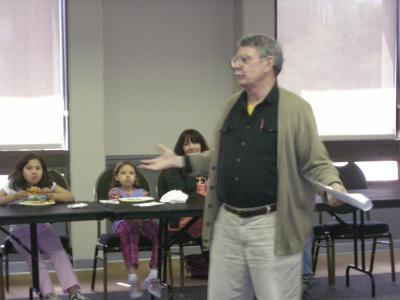Southern Miss Alum Urges Local Food Production as Part of EcoEagle Lecture
Thu, 03/17/2011 - 02:58pm | By: David Tisdale

A renewed emphasis on local farming, including small gardens established and cultivated by individuals in their own backyards, can improve the financial and physical health of the country.
That was the message from Allan Nation, featured speaker at Wednesday's first spring 2011 semester EcoEagle Lecture at The University of Southern Mississippi,sponsored by the university's Office of Sustainability. Nation also spoke about the impact of technology on food preparation, preservation and consumption, and ethnic influences on food production and preparation in South Mississippi.
“During and prior to World War II, about 40 percent of America's food production came from backyard gardens,” he said, noting also the success of “victory” gardens established and maintained during World War II. ‘What we've been through is a guide for how we can go back.”
Nation, a Southern Miss alumnus and member of the university's School of Mass Communication and Journalism Hall of Fame, is the editor and publisher of The Stockman Grass Farmer magazine. The international publication covers management-intensive grassland enterprises for producers of pasture-raised livestock.
He is also the author of The Moving Feast, published in 2009, which focuses on the history of food production in South Mississippi. Nation said a return to production and consumption of “heritage” foods, such as sweet potatoes, corn and sugar cane, among many others, would prove beneficial both economically and for individual health.
In the early 1900s, food produced in South Mississippi was sold or distributed no further than about 40 miles from the point of production. In 1936, there were about 28,000 farmers in Hattiesburg who grew almost all of the food consumed in the area. Today, it is rare to meet someone engaged in farming full-time, Nation said.
With the establishment of a rail line from Gulfport to Jackson in the late 1800s, Hattiesburg gained access to ice produced on the coast. This allowed families to keep food from spoiling. Previously, a family meal had to be consumed at once, as leftovers were not feasible.
“Before 1897, there was no refrigeration. Most milk went sour. We concentrated on small animals for meat at meals, including chickens and other fowl, fish and pork. For the first time, you didn't have to eat everything at the meal (to avoid waste),” he said.
Nation also discussed the ethnic influences on food production and preparation in South Mississippi, including by Native Americans, Scotch-Irish and African Americans, among others.
Sponsored by the Southern Miss Office of Sustainability, EcoEagle Lectures feature expert presenters and films that provide educational experiences on various topics in sustainability. For more information about the university's sustainability initiatives, online visit https://www.usm.edu/green.